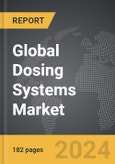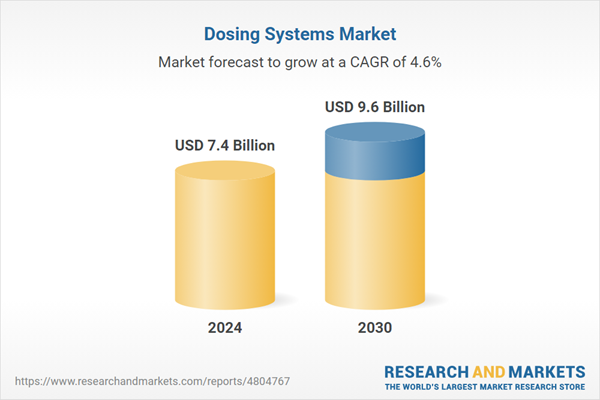The global market for Dosing Systems was valued at US$7.4 Billion in 2024 and is projected to reach US$9.6 Billion by 2030, growing at a CAGR of 4.6% from 2024 to 2030. This comprehensive report provides an in-depth analysis of market trends, drivers, and forecasts, helping you make informed business decisions. The report includes the most recent global tariff developments and how they impact the Dosing Systems market.
Segments: Type (Diaphragm, Piston, Other Types); Application (Water & Wastewater Treatment, Oil & Gas, Chemical Processing, Pharmaceuticals, Pulp & Paper, Other Applications).
Geographic Regions/Countries: World; United States; Canada; Japan; China; Europe (France; Germany; Italy; United Kingdom; and Rest of Europe); Asia-Pacific; Rest of World.
The analysts continuously track trade developments worldwide, drawing insights from leading global economists and over 200 industry and policy institutions, including think tanks, trade organizations, and national economic advisory bodies. This intelligence is integrated into forecasting models to provide timely, data-driven analysis of emerging risks and opportunities.
Global Dosing Systems Market - Key Trends and Drivers Summarized
What Are Dosing Systems and Why Are They Essential in Various Industries?
Dosing systems are precision devices designed to accurately control the flow of liquids, chemicals, or other substances in a wide range of industrial processes. These systems are crucial for ensuring the correct amount of a substance is dispensed, which is vital for maintaining product quality, safety, and efficiency in industries such as pharmaceuticals, water treatment, food and beverage, and chemical manufacturing. Dosing systems typically include components like pumps, valves, flow meters, and control units that work together to deliver precise quantities of materials. In pharmaceutical manufacturing, for example, dosing systems are used to ensure that the exact amount of an active ingredient is added to a formulation, thereby ensuring the effectiveness and safety of the medication. In water treatment, they are used to add chemicals like chlorine or fluoride in controlled amounts to purify drinking water, ensuring it meets safety standards. The accuracy and reliability of dosing systems are therefore critical to the success of numerous industrial processes.How Have Technological Advancements Enhanced the Functionality of Dosing Systems?
Technological advancements have significantly improved the functionality and versatility of dosing systems, enabling them to meet the increasingly complex demands of modern industries. Innovations such as digital control systems, smart sensors, and real-time monitoring capabilities have transformed traditional dosing systems into sophisticated tools that offer enhanced precision, flexibility, and efficiency. Digital dosing systems, for example, allow for precise control over the flow rate and volume of the dosed material, which can be easily adjusted and monitored through user-friendly interfaces. The integration of smart sensors enables real-time monitoring of dosing parameters, such as pressure, temperature, and flow rate, providing immediate feedback and allowing for adjustments on the fly to maintain optimal performance. Moreover, the advent of Internet of Things (IoT) technology has made it possible to remotely monitor and control dosing systems, offering greater flexibility and convenience for operators. These technological advancements are not only improving the accuracy and efficiency of dosing systems but also reducing the likelihood of human error, thus enhancing overall process safety and reliability.Where Are Dosing Systems Most Commonly Used and Why Are They Critical in These Applications?
Dosing systems are widely used across a variety of industries, each with specific requirements that make precision dosing critical. In the pharmaceutical industry, dosing systems are essential for the accurate preparation of medications, ensuring that each dose contains the correct amount of active ingredients, which is crucial for patient safety and treatment efficacy. In the food and beverage industry, dosing systems are used to add flavors, preservatives, and other additives in precise quantities to maintain product consistency and comply with food safety regulations. The chemical industry relies on dosing systems to mix and dispense hazardous substances accurately, minimizing waste and ensuring safe handling. Additionally, in the water treatment sector, dosing systems are vital for the accurate addition of chemicals that disinfect water and adjust its pH levels, ensuring that the water is safe for consumption and use. The widespread use of dosing systems across these diverse industries underscores their importance in maintaining the quality, safety, and efficiency of industrial processes.What Drives the Growth in the Dosing Systems Market?
The growth in the dosing systems market is driven by several factors, including the increasing demand for automation in industrial processes, the need for higher precision in manufacturing, and the rising emphasis on safety and regulatory compliance. As industries strive to improve efficiency and reduce operational costs, the adoption of automated dosing systems is accelerating, as these systems offer significant advantages in terms of accuracy, repeatability, and ease of use. The trend towards greater precision in manufacturing, particularly in sectors like pharmaceuticals and food and beverage, is also fueling the demand for advanced dosing systems that can deliver exact quantities with minimal variation. Additionally, the growing focus on safety and compliance with stringent regulations is driving the adoption of dosing systems that can ensure consistent product quality and reduce the risk of errors. Technological advancements, such as the integration of IoT and digital control systems, are further enhancing the capabilities of dosing systems, making them more adaptable and efficient. These factors, combined with the ongoing development of new applications for dosing systems in emerging industries, are expected to sustain and accelerate market growth in the coming years.Report Scope
The report analyzes the Dosing Systems market, presented in terms of units. The analysis covers the key segments and geographic regions outlined below.Segments: Type (Diaphragm, Piston, Other Types); Application (Water & Wastewater Treatment, Oil & Gas, Chemical Processing, Pharmaceuticals, Pulp & Paper, Other Applications).
Geographic Regions/Countries: World; United States; Canada; Japan; China; Europe (France; Germany; Italy; United Kingdom; and Rest of Europe); Asia-Pacific; Rest of World.
Key Insights:
- Market Growth: Understand the significant growth trajectory of the Diaphragm Dosing Systems segment, which is expected to reach US$5.6 Billion by 2030 with a CAGR of a 4.9%. The Piston Dosing Systems segment is also set to grow at 4.2% CAGR over the analysis period.
- Regional Analysis: Gain insights into the U.S. market, valued at $2.0 Billion in 2024, and China, forecasted to grow at an impressive 4.4% CAGR to reach $1.5 Billion by 2030. Discover growth trends in other key regions, including Japan, Canada, Germany, and the Asia-Pacific.
Why You Should Buy This Report:
- Detailed Market Analysis: Access a thorough analysis of the Global Dosing Systems Market, covering all major geographic regions and market segments.
- Competitive Insights: Get an overview of the competitive landscape, including the market presence of major players across different geographies.
- Future Trends and Drivers: Understand the key trends and drivers shaping the future of the Global Dosing Systems Market.
- Actionable Insights: Benefit from actionable insights that can help you identify new revenue opportunities and make strategic business decisions.
Key Questions Answered:
- How is the Global Dosing Systems Market expected to evolve by 2030?
- What are the main drivers and restraints affecting the market?
- Which market segments will grow the most over the forecast period?
- How will market shares for different regions and segments change by 2030?
- Who are the leading players in the market, and what are their prospects?
Report Features:
- Comprehensive Market Data: Independent analysis of annual sales and market forecasts in US$ Million from 2024 to 2030.
- In-Depth Regional Analysis: Detailed insights into key markets, including the U.S., China, Japan, Canada, Europe, Asia-Pacific, Latin America, Middle East, and Africa.
- Company Profiles: Coverage of players such as Blue-White Industries, Ltd., EMEC S.r.l.., Gee & Company (Effluent Control & Recovery) Limited,, Grundfos Holding A/S, Idex Corporation and more.
- Complimentary Updates: Receive free report updates for one year to keep you informed of the latest market developments.
Some of the 14 companies featured in this Dosing Systems market report include:
- Blue-White Industries, Ltd.
- EMEC S.r.l..
- Gee & Company (Effluent Control & Recovery) Limited,
- Grundfos Holding A/S
- Idex Corporation
- LEWA GmbH
- NETZSCH Pumpen & Systeme GmbH
- ProMinent GmbH
- Seko S.P.A.
- SPX Corporation
Tariff Impact Analysis: Key Insights for 2025
Global tariff negotiations across 180+ countries are reshaping supply chains, costs, and competitiveness. This report reflects the latest developments as of April 2025 and incorporates forward-looking insights into the market outlook.The analysts continuously track trade developments worldwide, drawing insights from leading global economists and over 200 industry and policy institutions, including think tanks, trade organizations, and national economic advisory bodies. This intelligence is integrated into forecasting models to provide timely, data-driven analysis of emerging risks and opportunities.
What’s Included in This Edition:
- Tariff-adjusted market forecasts by region and segment
- Analysis of cost and supply chain implications by sourcing and trade exposure
- Strategic insights into geographic shifts
Buyers receive a free July 2025 update with:
- Finalized tariff impacts and new trade agreement effects
- Updated projections reflecting global sourcing and cost shifts
- Expanded country-specific coverage across the industry
Table of Contents
I. METHODOLOGYII. EXECUTIVE SUMMARY2. FOCUS ON SELECT PLAYERSIII. MARKET ANALYSISIV. COMPETITION
1. MARKET OVERVIEW
3. MARKET TRENDS & DRIVERS
4. GLOBAL MARKET PERSPECTIVE
UNITED STATES
CANADA
JAPAN
CHINA
EUROPE
FRANCE
GERMANY
ITALY
UNITED KINGDOM
REST OF EUROPE
ASIA-PACIFIC
REST OF WORLD
Companies Mentioned (Partial List)
A selection of companies mentioned in this report includes, but is not limited to:
- Blue-White Industries, Ltd.
- EMEC S.r.l..
- Gee & Company (Effluent Control & Recovery) Limited,
- Grundfos Holding A/S
- Idex Corporation
- LEWA GmbH
- NETZSCH Pumpen & Systeme GmbH
- ProMinent GmbH
- Seko S.P.A.
- SPX Corporation
Table Information
| Report Attribute | Details |
|---|---|
| No. of Pages | 182 |
| Published | April 2025 |
| Forecast Period | 2024 - 2030 |
| Estimated Market Value ( USD | $ 7.4 Billion |
| Forecasted Market Value ( USD | $ 9.6 Billion |
| Compound Annual Growth Rate | 4.6% |
| Regions Covered | Global |









